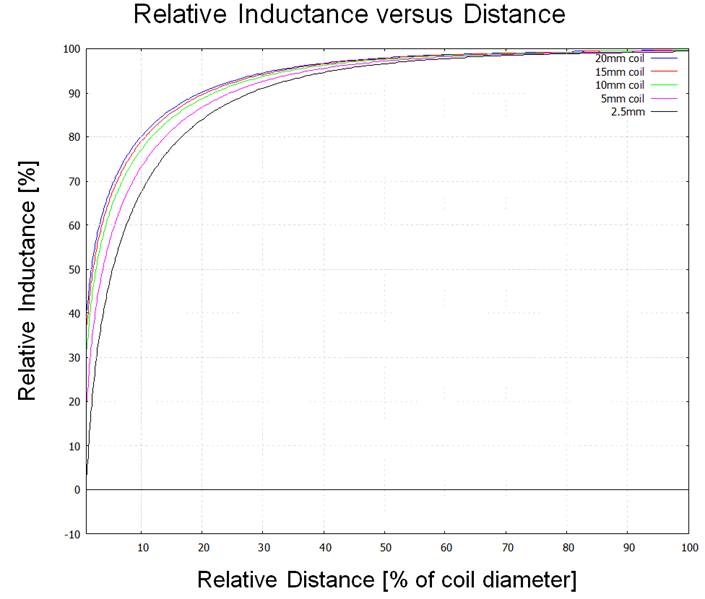SLYA048B March 2020 – June 2021 FDC1004 , FDC1004-Q1 , FDC2112 , FDC2112-Q1 , FDC2114 , FDC2114-Q1 , FDC2212 , FDC2212-Q1 , FDC2214 , FDC2214-Q1 , LDC0851 , LDC1001 , LDC1041 , LDC1051 , LDC1101 , LDC1312 , LDC1312-Q1 , LDC1314 , LDC1314-Q1 , LDC1612 , LDC1612-Q1 , LDC1614 , LDC1614-Q1 , LDC2112 , LDC2114 , LDC3114 , LDC3114-Q1
- Trademarks
- 1Inductive and Capacitive Theory of Operation
- 2FDC: Capacitive Level Sensing
- 3LDC: Inductive Touch Buttons
- 4LDC: Incremental Encoder and Event Counting
- 5LDC: Metal Proximity Sensor
- 6Revision History
5.2.2 Sensing Distance
Sensing distance is directly correlated to the size of the sensor coil. As a guideline, 1um-10cm is a viable sensing range for inductive technology. For most of the LDC devices, including the LDC131x family and the LDC3114, the maximum sensing range can be considered to be 50% of the coil diameter for higher precision applications. For low precision applications, such as a mere detection of metal presence, can be possible up to 100% of the coil diameter. The LDC161x family is the highest resolution LDC device and can add additional sensing range – this device family can sense targets up to 200% of the coil diameter. For simpler LDC metal proximity applications that only require a switch output, the LDC0851 can be considered; it can detect 40% of it’s coil diameter by using the side-by-side coil approach and up to 30% when using a stacked coil approach for size-constrained applications. For more information and tradeoffs between the two different sensor approaches with the LDC0851, see the LDC0851 Stacked Coil Design Considerations.
For a rectangular or elliptical coil, consider the shortest dimension to be the critical dimension when estimating the sensing distance.
Note that the sensitivity is the highest within 20% of the total sensing distance as seen in the below figure. This is because the relative inductance shift versus distance curve is logarithmic in nature and within the 20% cutoff, shorter shifts in distance equate to a stronger shift in relative inductance, allowing for µm level movements in the z-axis.
 Figure 5-4 Relative Inductance vs Distance
Figure 5-4 Relative Inductance vs Distance